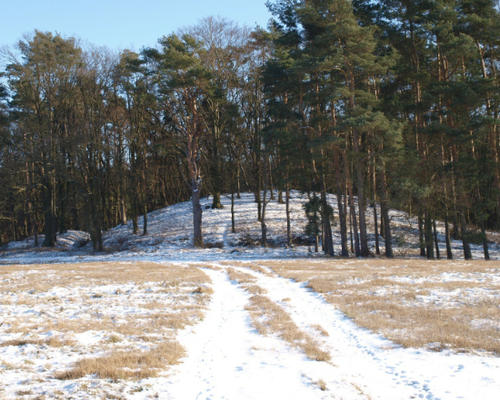Late Bronze Age landscape changes (Prignitz, northern Germany)
King's grave Seddin
Image Credit: Moritz Nykamp et al. CC BY 4.0
The monumental Late Bronze Age royal tomb of Seddin is located in the old moraine landscape of Prignitz, north-eastern Germany. Together with other richly furnished graves and a number of stone pits in its immediate vicinity, it provides evidence for the presence of a ninth to sixth century BC elite in this region.
The data
The map highlights the well-chosen location of the royal tomb in relation to the spatial arrangement of other archaeological monuments, which together form an ensemble of a ritual landscape. The map traces the legacy of land use from the Bronze Age to the present against the background of Late Quaternary landscape development. This includes the Bronze Age (re)shaping of the landscape for cultic and economic purposes, its medieval use for agriculture, its economic use and settlement history in historical times, and the modern melioration of agricultural land, which together form the palimpsest of today's landscape.
Publication of the dataset: Nykamp M, Hauschulz S et al (2022) https://doi.org/10.6084/m9.figshare.18146903.v2
Research Results
The map (see "The data") integrates the classical approach of geomorphological mapping, the documentation of archaeological finds in the Late Bronze Age ritual landscape of Seddin, and aspects of settlement development and land use strategies in historical times up to the recent past. These testimonies illustrate the appearance of today's landscape and document the natural and anthropogenic processes involved in shaping it. The 106 known burial mounds in the vicinity of the royal grave at Seddin as well as the row of stone pits in its immediate vicinity document the (re)shaping of the landscape for cultic purposes during the Late Bronze Age. Due to its isolated location on a slight spur, its enormous dimensions and the numerous burial mounds in its vicinity, the royal tomb undoubtedly shaped the Late Bronze Age ritual landscape of Seddin. The setting in which the burial mounds are embedded, the arrangement of their locations and the high visibility of the royal tomb suggest a profound knowledge of the landscape in which they lived on the part of the tomb-makers.
Publication of the journal article: Nykamp M, Hauschulz S et al (2022) https://doi.org/10.1080/17445647.2021.2020178
Text modified after Nykamp M, Hauschulz S et. al. (2022): 10.1080/17445647.2021.2020178
